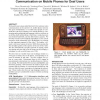Free Online Productivity Tools
i2Speak
i2Symbol
i2OCR
iTex2Img
iWeb2Print
iWeb2Shot
i2Type
iPdf2Split
iPdf2Merge
i2Bopomofo
i2Arabic
i2Style
i2Image
i2PDF
iLatex2Rtf
Sci2ools
UIST
2009
ACM
2009
ACM
Activity analysis enabling real-time video communication on mobile phones for deaf users
We describe our system called MobileASL for real-time video communication on the current U.S. mobile phone network. The goal of MobileASL is to enable Deaf people to communicate with Sign Language over mobile phones by compressing and transmitting sign language video in real-time on an off-the-shelf mobile phone, which has a weak processor, uses limited bandwidth, and has little battery capacity. We develop several H.264-compliant algorithms to save system resources while maintaining ASL intelligibility by focusing on the important segments of the video. We employ a dynamic skin-based region-of-interest (ROI) that encodes the skin at higher quality at the expense of the rest of the video. We also automatically recognize periods of signing versus not signing and raise and lower the frame rate accordingly, a technique we call variable frame rate (VFR). We show that our variable frame rate technique results in a 47% gain in battery life on the phone, corresponding to an extra 68 minutes ...
| Added | 28 May 2010 |
| Updated | 28 May 2010 |
| Type | Conference |
| Year | 2009 |
| Where | UIST |
| Authors | Neva Cherniavsky, Jaehong Chon, Jacob O. Wobbrock, Richard E. Ladner, Eve A. Riskin |
Comments (0)

